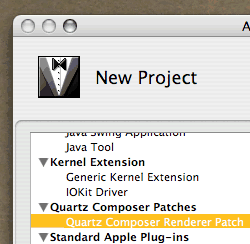Announcing: kineme.net

Along with the new site, a few new patches are available as well based on requests from users.
Posts relating to <code>software development</code>.

Along with the new site, a few new patches are available as well based on requests from users.
While writing the new Image Downloader (Blocking) QC patch for CoreMelt, I ran into what appears to be a bug in Mac OS X’s NSURLConnection framework – if you construct an NSURLRequest and specify a timeout of less than 30 seconds, it’s ignored when you perform a [NSURLConnection sendSynchronousRequest:returningResponse:error:]. The request takes at least 30 seconds to time out, contrary to what the documentation suggests..
Steps to Reproduce:

Whipping out some jpeg-format-and-filesystem-jutsu, here’s the solution (for less than that $20 shareware recovery utility):

- (void)setMaxIndexValue:(unsigned int)max;.
Changes:
Download the installer, version 0.2.
See the old version’s blogpost for some additional instructions and user comments.
Steve Mokris is a developer at Kosada, Inc.

Being open source, their projects and products are often enhanced by the contributions of others. These contributions often come in the form of a “patch” – a file that tells the computer what to change in the source code to add the contribution.
In addition to writing the inspector panels for custom Quartz Composer patches tutorial, I spent this weekend writing up some advanced custom-patch-development documentation and posted it on QC Wiki:
Steve Mokris is a developer at Kosada, Inc.


Frustrated with the tedium of going through all the Xcode project files in a text editor and manually replacing all of the identifiers and filenames when creating a new Quartz Composer Patch, I decided to finally figure out how to create a new Xcode template.
After working my way through most of the migration to Mac, I came across a common problem for multi-platform developers like myself. The problem is the creation and use of applications targeted for another platform. For example, using a Linux compiler to develop Windows applications, or using an OS X compiler to develop Linux applications.
This is a fairly common problem, and also fairly simple to solve. The resultant tool kit is referred to as a Cross-Compiler, because is crosses platforms, and it compiles source code into target code. For Linux, my cross-compiler of choice was created and maintained by SDL, and can be found here. This allowed me to write Windows programs without needing to actually run Windows. Since both Linux and Windows were my complete set of frequented platforms, that sufficed. Now, however, one more platform has entered the mix.